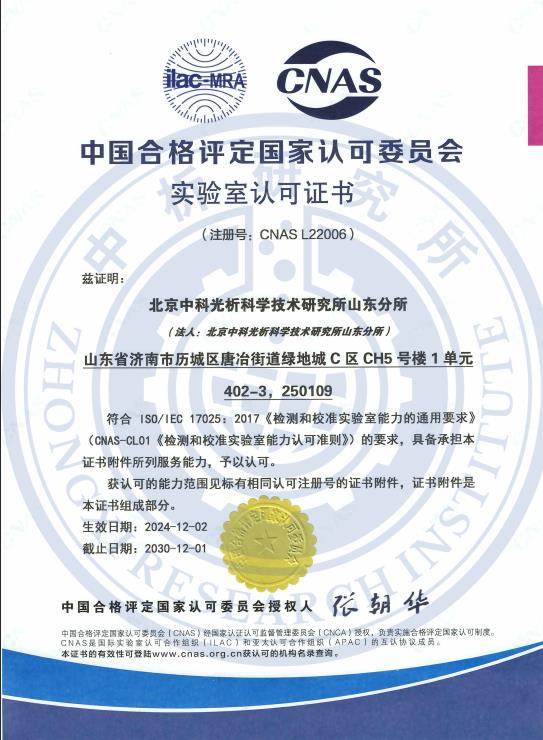粉、粒听装包装生产线检测
1对1客服专属服务,免费制定检测方案,15分钟极速响应
发布时间:2025-07-03 20:31:44 更新时间:2025-07-02 20:31:45
点击:0
作者:中科光析科学技术研究所检测中心
1对1客服专属服务,免费制定检测方案,15分钟极速响应
发布时间:2025-07-03 20:31:44 更新时间:2025-07-02 20:31:45
点击:0
作者:中科光析科学技术研究所检测中心
In the modern packaging industry, the inspection of powder and granule tin can packaging production lines plays a crucial role in ensuring product quality, safety, and regulatory compliance. Powder and granule products, such as coffee, spices, pharmaceuticals, or chemicals, are often packaged in tin cans due to their durability and ability to preserve freshness. However, these production lines face unique challenges, including potential leakage, contamination, weight inconsistencies, and seal failures, which can lead to significant financial losses, recalls, or health hazards if undetected. Proper inspection is essential to maintain high standards, meet customer expectations, and adhere to global supply chain demands. This involves automated and manual processes that integrate advanced technologies to monitor every stage of the packaging process, from filling and sealing to labeling and palletizing. By implementing robust inspection protocols, manufacturers can prevent defects, reduce waste, and enhance efficiency, ultimately contributing to sustainable practices and consumer trust in fast-moving consumer goods (FMCG) sectors.
Inspection items for powder and granule tin can packaging production lines focus on key quality parameters that ensure the integrity and safety of the final product. First, seal integrity inspection checks for leaks or improper sealing of the tin can lids, which is critical to prevent oxidation or contamination during storage and transport. Second, weight verification ensures that the fill level is accurate and consistent, adhering to specified tolerances (e.g., ±1-2% of target weight) to avoid underfilling or overfilling. Third, appearance and labeling inspection examines the can's exterior for defects like dents, scratches, or misprinted labels, which impact brand image and compliance. Fourth, contaminant detection identifies foreign objects such as metal shards, glass, or plastic particles that could pose health risks. Additionally, filling level and homogeneity checks confirm that the powder or granules are evenly distributed without clumping or segregation. These items are often prioritized based on risk assessment, with critical points like seal and contaminant checks being mandatory in high-risk industries like food or pharmaceuticals.
A variety of advanced instruments are employed to carry out inspections on powder and granule tin can packaging lines, enabling precise, non-destructive testing. For weight verification, automated checkweighers are used; these high-precision scales measure the mass of each can in real-time, rejecting underweight or overweight units with conveyor-based sorting systems. For seal integrity, vacuum decay testers or pressure decay sensors detect leaks by monitoring pressure changes. Contaminant detection relies on instruments like metal detectors, which use electromagnetic fields to identify ferrous and non-ferrous metals, and X-ray inspection systems, which scan for foreign objects, density variations, or fill level issues. For appearance checks, vision inspection systems with cameras and AI algorithms analyze surface defects and label placement. Additionally, sampling probes and sensors for humidity or temperature monitor environmental conditions. These instruments are integrated into the production line, often with IoT connectivity for data logging and remote monitoring, ensuring minimal downtime and high throughput.
Inspection methods for powder and granule tin can packaging lines combine automated, inline processes with periodic manual checks to ensure comprehensive quality control. Inline automated inspection is the primary method, where instruments like checkweighers or X-ray systems are positioned at critical points on the conveyor belt, performing real-time scans on every can as it moves through the line. For example, a typical sequence involves weight measurement at the filling station, seal testing after capping, and contaminant scanning before labeling. Defective units are automatically rejected via air jets or mechanical arms. Sampling-based methods involve periodic offline testing, such as destructive tests on randomly selected cans to validate seal strength or chemical analysis for contaminant residues. Manual inspection supplements automation through visual checks by trained operators at intervals, focusing on subtle defects that machines might miss. Methods also include statistical process control (SPC) for trend analysis and predictive maintenance to prevent instrument failures. This multi-layered approach ensures reliability, with methods tailored to the product type—e.g., fine powders may require vibration tests for fill consistency, while granules need agitation checks.
Inspection standards for powder and granule tin can packaging lines are governed by international, national, and industry-specific regulations to ensure uniformity and safety. Key standards include ISO 22000:2018 for food safety management, which mandates hazard analysis and critical control points (HACCP) for contaminant detection and seal integrity. ISO 9001:2015 sets general quality management requirements, covering documentation, calibration of instruments, and continuous improvement processes. For specific regions, standards like the US FDA Food Safety Modernization Act (FSMA) enforce strict guidelines for foreign object detection in edible products, while the European Union's EN 13193 regulates packaging materials for compatibility and toxicity. Industry standards such as HACCP principles detail risk-based inspection frequencies, and AIB International standards provide benchmarks for sanitation and equipment design. Compliance involves regular audits, documentation of results, and calibration to traceable references (e.g., NIST for weights). These standards evolve with technological advancements, ensuring that inspection protocols remain rigorous and adaptable to new challenges.

证书编号:241520345370

证书编号:CNAS L22006

证书编号:ISO9001-2024001















版权所有:北京中科光析科学技术研究所京ICP备15067471号-33免责声明